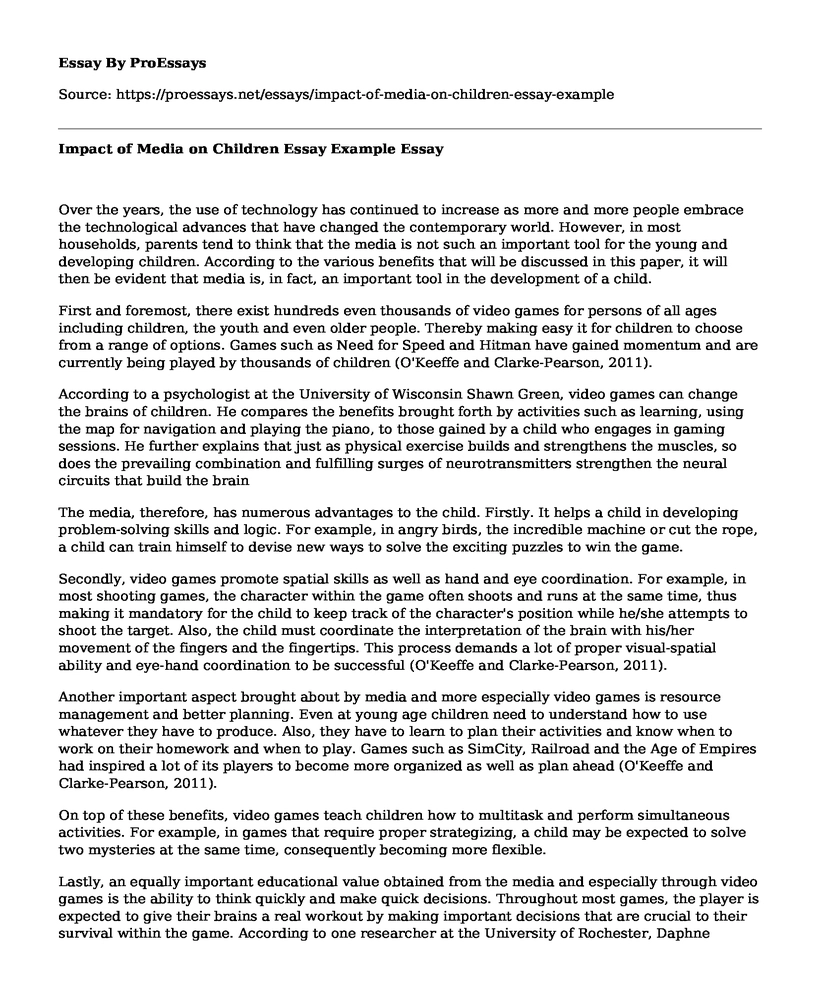Over the years, the use of technology has continued to increase as more and more people embrace the technological advances that have changed the contemporary world. However, in most households, parents tend to think that the media is not such an important tool for the young and developing children. According to the various benefits that will be discussed in this paper, it will then be evident that media is, in fact, an important tool in the development of a child.
First and foremost, there exist hundreds even thousands of video games for persons of all ages including children, the youth and even older people. Thereby making easy it for children to choose from a range of options. Games such as Need for Speed and Hitman have gained momentum and are currently being played by thousands of children (O'Keeffe and Clarke-Pearson, 2011).
According to a psychologist at the University of Wisconsin Shawn Green, video games can change the brains of children. He compares the benefits brought forth by activities such as learning, using the map for navigation and playing the piano, to those gained by a child who engages in gaming sessions. He further explains that just as physical exercise builds and strengthens the muscles, so does the prevailing combination and fulfilling surges of neurotransmitters strengthen the neural circuits that build the brain
The media, therefore, has numerous advantages to the child. Firstly. It helps a child in developing problem-solving skills and logic. For example, in angry birds, the incredible machine or cut the rope, a child can train himself to devise new ways to solve the exciting puzzles to win the game.
Secondly, video games promote spatial skills as well as hand and eye coordination. For example, in most shooting games, the character within the game often shoots and runs at the same time, thus making it mandatory for the child to keep track of the character's position while he/she attempts to shoot the target. Also, the child must coordinate the interpretation of the brain with his/her movement of the fingers and the fingertips. This process demands a lot of proper visual-spatial ability and eye-hand coordination to be successful (O'Keeffe and Clarke-Pearson, 2011).
Another important aspect brought about by media and more especially video games is resource management and better planning. Even at young age children need to understand how to use whatever they have to produce. Also, they have to learn to plan their activities and know when to work on their homework and when to play. Games such as SimCity, Railroad and the Age of Empires had inspired a lot of its players to become more organized as well as plan ahead (O'Keeffe and Clarke-Pearson, 2011).
On top of these benefits, video games teach children how to multitask and perform simultaneous activities. For example, in games that require proper strategizing, a child may be expected to solve two mysteries at the same time, consequently becoming more flexible.
Lastly, an equally important educational value obtained from the media and especially through video games is the ability to think quickly and make quick decisions. Throughout most games, the player is expected to give their brains a real workout by making important decisions that are crucial to their survival within the game. According to one researcher at the University of Rochester, Daphne Bavelier, games can be used as stimulating activities especially in the case of action games.
Nonetheless, video games and media, in general, has not been without its downsides. To begin with, video games can be addictive. As of 2018, among addition was declared a mental health disorder. This makes the children dependant on the internet, or televisions thus reducing their overall efficiency.
Secondly, too much media for the children can make them lack emotional connection. This makes it difficult for them to interact with other children thus they end up anti-social. As a result, children should be supervised when it comes to its usage so that they can know when to stop and attend to other matters (O'Keeffe and Clarke-Pearson, 2011).
Still, it has become evident that the media has made children more violent. For instance, in the case of video games, the interactive nature of the games has resulted in kids imitating acts of violence and practicing them, especially in school among their peers when there is no supervision. Within the games, the active, constant participation and reward after fighting, killing or stabbing become effective tools for learning for the children. Consequently, many studies have revealed that violent video games are related to aggressive behaviors in children (Bushman Gollwitzer and Cruz, 2015).
Conclusion
In conclusion, therefore, in as much as the media has proven to be beneficial among young children, it has also brought forth a couple of negative effects. In addition to the benefits discussed above, there exists many more that have not been analyzed. However, it is always important for children to use the media under supervision.
Works Cited
Bushman, B. J., Gollwitzer, M., & Cruz, C. (2015). There is broad consensus: Media researchers agree that violent media increase aggression in children and pediatricians and parents concur. Psychology of Popular Media Culture, 4(3), 200.
O'Keeffe, G. S., & Clarke-Pearson, K. (2011). Clinical report-the impact of social media on children, adolescents, and families. Pediatrics, peds-2011.
Cite this page
Impact of Media on Children Essay Example. (2022, Aug 15). Retrieved from https://proessays.net/essays/impact-of-media-on-children-essay-example
If you are the original author of this essay and no longer wish to have it published on the ProEssays website, please click below to request its removal:
- How to Photograph Food?
- Poverty, Money, and Politics in the United States
- Psychology Paper Sample on Children's Cognitive Development
- My Avalanche of Kindness Essay Example
- Reflection Essay on Popular Culture: Reality Television
- Essay on The Dangers of a Single Story: Chimamanda Ngozi Adichie's Powerful 20-Minute Video
- Free Paper on Adderall Abuse Among College Students: Causes, Effects, and Societal Concerns







